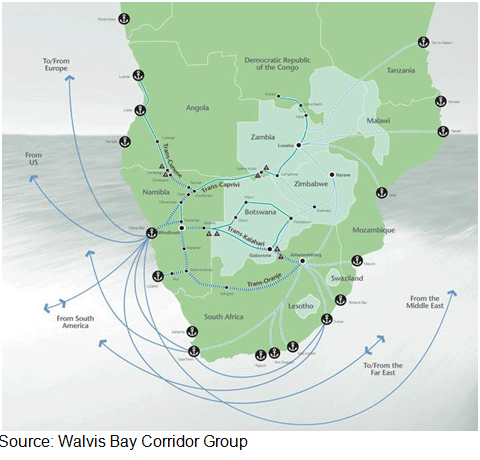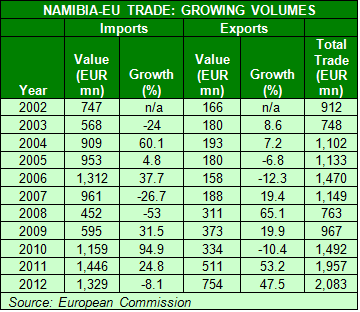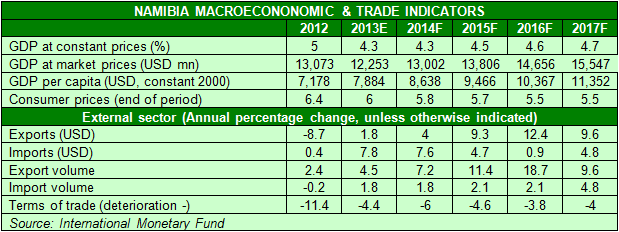Namibian port poised to be logistics hub
 Photo Credit:REUTERS/STR NewNamibia's Walvis Bay could emerge as southern African states' gateway to Europe.
Photo Credit:REUTERS/STR NewNamibia's Walvis Bay could emerge as southern African states' gateway to Europe.
Walvis Bay is already Namibia's largest commercial port and links the country's multimodal transport corridors to local, southern landlocked countries and international markets, according to the African Development Bank (AfDB).
Late last year, the port of Walvis Bay and the AfDB signed a loan agreement to expand the project at a cost of NAD 3 billion (USD 280 million).
The expansion will include the construction of a new container terminal spread over 40 hectares of land and increase the port's capacity to 650,000 TEU per annum compared to the existing 350,000 TEUs per annum.
The expansion, which is set to be completed by 2017, will raise the port's bulk goods handling capacity by freeing up the existing container terminal.
The port expansion project complements Namibia's vision of becoming the logistics hub for southern Africa, the two parties said.
"In addition to the facilitation of flows of trade and trans-shipments via Namibia, one of the great opportunities for the country is to be positioned as a logistical hub to take advantage of rapid economic growth in a number of SADC countries," AfDB noted.
The availability of a good international logistics network in Namibia (offering services ranging from transport and storage solutions to customized integrated supply chain management services) is likely to create employment opportunities for Namibians.
The port already receives about 3,000 vessels and handles five million tons of cargo each year.
BETTER THAN THE COMPETITION
"It has good port infrastructure, which ranks among the best in Africa and offers competitive tariffs. It is less congested than its main competitors in east and southern Africa," AfDB said in a new report.
The Walvis Bay Corridor is a network of transport links that connect Namibia to other southern African countries. These include the Trans-Caprivi Corridor, which can be accessed by road and rail and is used to transport exports and imports for Zambia, Zimbabwe, the Democratic Republic of Congo and Malawi.
The Trans-Kalahari Corridor is accessible via road and rail and is mainly used by Botswana and the northern provinces of South Africa, specifically Gauteng region.
Meanwhile, the Trans-Cunene Corridor connects southern Angola through Tsumeb, primarily to transport goods and construction materials imported for the redevelopment of southern Angola.
The Port of Luderitz, further south of Walvis, is also emerging as an important base for fishing, mining, and offshore diamond mining industries, apart from being a base for oil and gas drilling operations off the southern coast.
Namibia is keen to emerge as the regional hub thanks to Walvis Bay's strategic position and shorter transit times to Europe. The strong transportation network benefits neighboring countries too, including the DRC, Malawi and Zimbabwe along the Walvis Bay Corridors as it offers the shortest possible regional route on the west coast.

 ECONOMIC DRIVERS
ECONOMIC DRIVERS
The Walvis port's expansion will allow Namibia to build on its strengths as a strong economic performer in the region. The country's real GDP is expected to average 5% per annum over the next two years, as investors injected funds into mining projects, the AfDB said.
The International Monetary Fund expects a more subdued 4.5% growth by 2016, "supported by the strong construction sector owing to a planned public housing program and recovery in the mining sector through the full-capacity production of the Husab uranium mine."
The country is also looking to improve the performance of the Export Processing Zones and develop manufacturing facilities that would leverage its transport strength, the IMF noted.
"Their current strategy involves developing commodity-based value chains to enhance growth and economic diversification," the IMF said. "This strategy also involves a comprehensive review that aims to improve the investment climate, the ease of doing business, support SMEs and pursue deeper economic integration."
 TRADING NATION
TRADING NATION
Namibia benefits from being part of the Southern African Customs Union (SACU) comprising South Africa, Botswana, Lesotho and Swaziland. The union feature common external tariffs and guarantees the free movement of goods among the member states under SACU's Common Monetary Area (CMA) program.
The CMA has helped stabilize Namibia's monetary and exchange rate policies and helped the economy integrate with its more advanced South African financial market.
It has also enabled the country to enjoy an unrestricted transfer of funds. Recognizing the benefits that it could get from a larger market, with a single economic space, Namibia is participating in negotiations to create the Common Market of Eastern and Southern Africa, East African Community and SADC (COMESA-EAC-SADC) tripartite free trade area, according to the IMF.
Namibia is also a member of the 15-state Southern African Development Community of mostly southern states focused on socio-economic integration and security issues.
"Namibia is a great advocate of regional integration owing to its small domestic market and the need to benefit from economies of scale," the AfDB said.
"Its membership of SADC provides it with opportunities for expanding and diversifying its export markets through access to a regional market of close to 400 million people."
More crucially, the Namibian government is keen to conclude the Economic Partnership Agreement (EPA) with the European Union by October 2014. Failure to finalize the deal will end Namibia's duty-free exports of beef, fish and grapes to the European market. The country reportedly earns NAD 5 billion (or USD 465 million) of its exports from these commodities.
The feature was produced by alifarabia.com exclusively for zawya.com.



















 Photo Credit:REUTERS/STR New
Photo Credit:REUTERS/STR New










